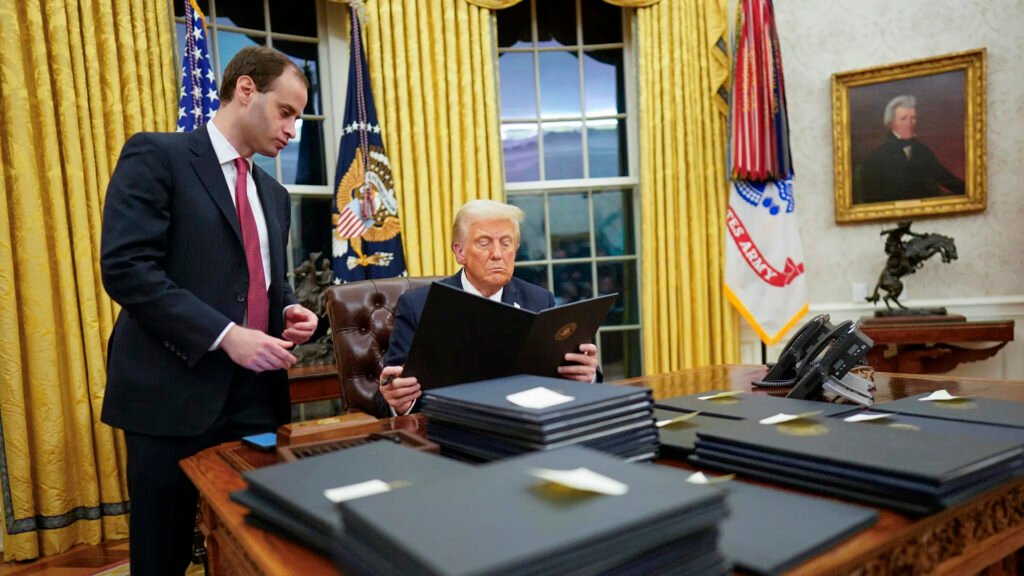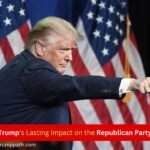In April 2025, President Donald J. Trump signed a series of executive orders and proclamations aimed at reshaping America’s economic and industrial landscape. These actions, including opening Pacific waters to commercial fishing and implementing reciprocal trade tariffs, reflect his “America First” agenda and build on promises made during his 2024 presidential campaign. This analysis dives into two key executive actions, breaking down their intent, potential impacts on the economy, environment, and industries, and their alignment with Trump’s campaign pledges. Below, we explore what these orders mean for America and invite you to share your thoughts on how they might affect your life.
Executive Order: Restoring American Seafood Competitiveness

On April 17, 2025, Trump signed an Executive Order titled “Restoring American Seafood Competitiveness,” aimed at revitalizing the U.S. fishing industry by reducing regulatory burdens and combating unfair foreign trade practices. This follows a proclamation on the same day that reopened over 400,000 square miles of Pacific waters to commercial fishing, reversing Obama-era restrictions under the Pacific Remote Islands Marine National Monument (PRIMNM).
What the Order Means
- Deregulation of Fisheries: The order directs the Secretary of Commerce to suspend, revise, or rescind regulations deemed overly burdensome on commercial fishing, aquaculture, and fish processing within 30 days. It targets restrictive catch limits and outdated data collection methods.
- Technological Modernization: The National Marine Fisheries Service (NMFS) is tasked with adopting advanced technologies, expanding cooperative research, and modernizing data analytics to improve fishery management responsiveness.
- America First Seafood Strategy: The order establishes a strategy to boost U.S. seafood production, sales, and exports, while addressing illegal, unreported, and unregulated (IUU) fishing and low foreign environmental standards. It also calls for a review of marine national monuments to potentially open them to fishing.
- Pacific Waters Access: The proclamation lifts bans on commercial fishing in the PRIMNM, arguing that migratory fish like tuna are not effectively protected by these restrictions, and American fishermen have been disadvantaged against foreign fleets, particularly from China.

Potential Impacts
- Economy:
- Positive: The order could create jobs in coastal communities, particularly in American Samoa, by restoring access to prime fishing grounds. The U.S. seafood industry, valued at $320 billion, may see increased production and exports, strengthening local economies.
- Challenges: Short-term disruptions are possible due to a 60-day regulatory freeze earlier in 2025, which delayed fishery management and caused over-fishing in some regions, potentially affecting quotas and market stability.
- Environment:
- Concerns: Environmental groups warn that opening protected waters could harm marine ecosystems, including endangered species like Hawaiian monk seals, and increase risks of over-fishing. The lack of robust environmental safeguards in the order raises fears of long-term ecological damage.
- Counterpoint: The administration argues that modernized data collection and cooperative research will ensure sustainable fishing, though critics note these measures are untested at scale.
- Industries:
- Fishing Industry: Fishermen gain access to lucrative Pacific waters, potentially increasing catches and profits. However, small-scale operators may struggle with competition from larger fleets.
- Related Sectors: Aquaculture and fish processing could benefit from reduced regulations, but tourism and recreation industries reliant on pristine marine environments may face losses.
Alignment with 2024 Campaign Promises

- Economic Growth: Trump’s campaign emphasized revitalizing American industries through deregulation, promising to “bring back jobs” and boost sectors like fishing. This order aligns with his pledge to reduce federal overreach and support maritime jobs.
- America First: The focus on combating IUU fishing and unfair trade practices echoes Trump’s commitment to leveling the playing field against foreign competitors, particularly China.
- Energy and Resource Access: While primarily about fishing, the order’s review of marine monuments ties to Trump’s broader promise to open federal lands and waters for resource extraction, as seen in his “drill, baby, drill” rhetoric.
Summary
- Intent: Reduce regulations, modernize fishery management, and reopen Pacific waters to boost U.S. seafood competitiveness.
- Economic Impact: Potential job growth and increased seafood production, but short-term disruptions possible.
- Environmental Impact: Risks to marine ecosystems and endangered species, with unproven sustainability measures.
- Industry Impact: Benefits for fishing and aquaculture, potential losses for tourism.
- Campaign Alignment: Fulfills promises of deregulation, job creation, and countering foreign trade imbalances.
Executive Order: Declaring a National Emergency for Reciprocal Trade Tariffs

On April 2, 2025, Trump declared a national emergency under the International Emergency Economic Powers Act (IEEPA) to impose reciprocal tariffs, addressing trade deficits and unfair foreign trade practices. This action, effective April 5, 2025, includes a 10% tariff on all imports and higher tariffs on countries with significant U.S. trade deficits.
What the Order Means
- Reciprocal Tariffs: A 10% tariff applies to all imports, with additional tariffs targeting countries like the European Union (10% on vehicles vs. U.S.’s 2.5%) and India (70% on vehicles). The goal is to match foreign tariff rates to protect American industries.
- Trade Deficit Reduction: The order addresses a $1.2 trillion goods trade deficit in 2024, blaming foreign practices like currency manipulation and high value-added taxes (VAT).
- National Security: Trump frames trade imbalances as a threat to economic and national security, citing the loss of 5 million manufacturing jobs from 1997 to 2024 and dependence on foreign supply chains.
- Made in America: The order promotes domestic manufacturing by incentivizing production through tariff protections, aligning with the “Made in America” agenda.
Potential Impacts
- Economy:
- Positive: Tariffs could incentivize domestic manufacturing, potentially creating jobs in sectors like steel and automotive. The administration claims trillions in revenue, though estimates vary.
- Challenges: Economists warn of higher consumer prices, with long-term inflation expectations at a three-decade high. Retailers predict cost increases for goods, disproportionately affecting lower-income households. Equity markets have dropped, and growth forecasts are cut due to trade uncertainty.
- Environment:
- Indirect Effects: Increased domestic manufacturing may boost fossil fuel use, conflicting with climate goals. However, the order doesn’t directly address environmental policy.
- Global Trade: Tariffs may disrupt supply chains, prompting allies like the EU and UK to diversify trade, potentially reducing U.S. influence in global markets.
- Industries:
- Manufacturing: Steel and automotive sectors may gain from tariff protections, but industries reliant on imports (e.g., electronics) face higher costs. Trump’s 2018 tariffs created 1,000 steel jobs but cost 75,000 in steel-using industries.
- Retail and Consumers: Higher import costs could raise prices for goods like cars and appliances, impacting consumer spending.
Alignment with 2024 Campaign Promises
- Economic Revival: Trump promised to lower prices and revive manufacturing, but tariffs may increase costs, contradicting his pledge to make America affordable. The focus on job creation aligns with his campaign, though outcomes depend on execution.
- Trade Fairness: The order delivers on Trump’s vow to confront unfair trade practices, a cornerstone of his 2024 platform, by targeting countries with high tariffs and deficits.
- National Security: Framing trade as a security issue ties to Trump’s promise to protect critical supply chains and reduce reliance on adversaries like China.
Summary
- Intent: Impose reciprocal tariffs to reduce trade deficits and protect American industries.
- Economic Impact: Potential manufacturing job growth but higher consumer prices and market volatility.
- Environmental Impact: Indirect increase in fossil fuel use; no direct environmental focus.
- Industry Impact: Benefits for manufacturing, challenges for import-reliant sectors and consumers.
- Campaign Alignment: Aligns with trade fairness and security promises but risks contradicting affordability goals.
These executive orders signal Trump’s intent to prioritize economic nationalism and deregulation, consistent with his 2024 campaign’s focus on reviving American industries and countering foreign competition. However, they raise critical questions:
- Economic Trade-Offs: Will job gains in fishing and manufacturing outweigh price increases and market disruptions?
- Environmental Risks: Can modernized fishery management prevent ecological harm, or are protected marine areas at risk?
- Global Standing: Will tariffs strengthen U.S. industries or alienate trade partners, reducing America’s Geo-economic influence?
The success of these orders depends on implementation, legal challenges, and public response. For instance, environmental groups may sue to block fishing in protected waters, as they did during Trump’s first term. Meanwhile, tariff-induced price hikes could test public support among Trump’s base, particularly lower-income voters.
What do you think? How might these executive orders affect your job, community, or the environment where you live? Are Trump’s policies delivering on his campaign promises, or do they risk unintended consequences? Share your thoughts in the comments below—we’d love to hear your perspective!



